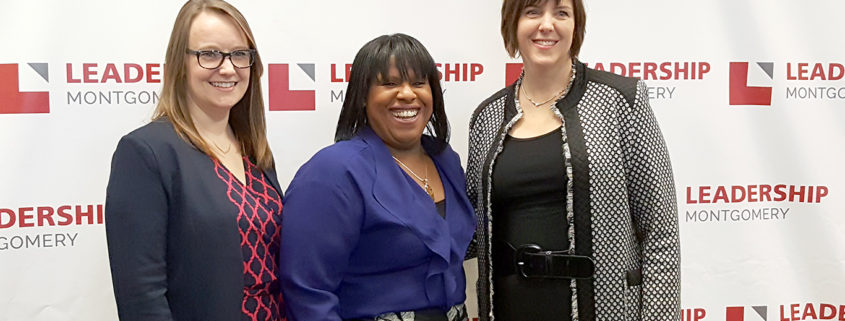Coming Together from a Place of Strength, Not Weakness
In January, Leadership Montgomery, a small but influential nonprofit leadership center in Maryland, unveiled its new strategic plan, complete with a new mission, vision, and way of talking about the organization’s community impact.
This shift followed a time of deep reflection for the organization. For nearly 30 years, Leadership Montgomery had brought together private, public, and nonprofit professionals through leadership trainings and service activities that broaden perspectives and build connections for community improvement. But with a new CEO at the helm, it was time for a step back to move forward—to reframe tired language and re-examine the organization’s role and relevance within the community.
Leadership Montgomery timed the unveiling of its new strategic plan so that it coincided with the announcement of a major expansion of its programming—via the addition of another small but influential nonprofit called the Corporate Volunteer Council of Montgomery County (CVC). CVC trains businesses on how to build effective volunteer and charitable programs, and it too had been going through a time of reflection; its board wondered how it would or could scale CVC’s model to more effectively interlace with the region’s business and community leaders.
“The needs of our county have evolved,” said Leadership Montgomery’s new CEO during the public announcement. “As I’ve listened to what our members, our graduates, and our partners desire in leadership programming, I’ve realized without hesitation that with CVC, we can deliver more for those whom we support, and we can pull our community closer together in the process.”
The pairing of the organizations was widely commended, with most people echoing one simple line: This just makes sense. Others, however, met the news with skepticism: Why would two charities come together unless one was weak and needed saving? The perception among this group seemed to be that going it alone was the true measure of strength—that one of these two organizations must not be measuring up when it came to the number of people supported, organizations improved, or service activities completed. It didn’t occur to them that, through partnership, the strong could become even stronger.
Since its founding, Leadership Montgomery has graduated more than 2,000 leaders, 955 of whom now hold board seats in County-based businesses; supported 864 local nonprofits with 25,000 hours of volunteer service; and trained 476 high school and other emerging leaders. The CVC was recently named Corporate Volunteer Council of the Year by Points of Light for its outstanding commitment to corporate and community engagement. Both were independently strong organizations. However, to spur more significant, mission-moving change, Leadership Montgomery realized it needed to think very differently about its delivery mechanism. The answer wasn’t more programming, more sponsorship opportunities, or even more graduates. Rather, it was a realization that through calculated risk and collaboration with a complementary nonprofit, its value could skyrocket.
The calculated risk to bring the programming of CVC into Leadership Montgomery’s service model was not only a smart business decision with short- and long-term payoff, but also a great example of two organizations coming together from a place of strength, to support their respective communities in new ways.
According to the National Center for Charitable Statistics, there are nearly 1.6 million active nonprofit organizations in the United States, many delivering the same or similar services. These organizations put a lot of time and effort into reviewing and refining their missions, but they often spend far less time thinking about how in-sector collaboration can move their own missions forward.
Rather than trying to tackle every challenge or advance every idea with the same team of executives and board members, Leadership Montgomery considered how the experience—and the identified solutions—might change if the perspective and people at its table changed. Its intentional collaboration with CVC has already resulted in several short-term business wins with long-term payoff; donors that had fallen inactive found new value in the expanded set of offerings.
So what made the Leadership Montgomery collaboration take hold, and what can other nonprofits learn from it? Here are three takeaways to consider:
- Create an agenda, but focus on the action. Leadership Montgomery’s CEO sought input from a wide cross-section of individuals and groups in the creation of the strategic plan, and then found a compelling way to bring it to life immediately through a thoughtfully conceived expansion of services.
- The message matters. Leadership Montgomery anticipated questions about organizational weakness and stayed one step ahead by focusing on the value this partnership would bring to the region. It took the time to prepare and then tell the story of why the collaboration made sense for both the organizations and the communities they support.
- Find a buddy who shares your vision. Leadership Montgomery and CVC had a clear, shared sense of a bigger, bolder vision. The organizations took the necessary time to assess the work that they were trying to do in the community and determined that deeper integration would result in greater impact.
This year, tens of thousands of nonprofits will explore new and better ways to deliver on their missions. As they do, Leadership Montgomery’s pivot towards partnership can serve as an important reminder that our greatest strength is rarely revealed by itself. With a collaborative spirit and a willingness to question the expected, our best is yet to be.
This article originally appeared in the Stanford Social Innovation Review.





 Check out our new
Check out our new